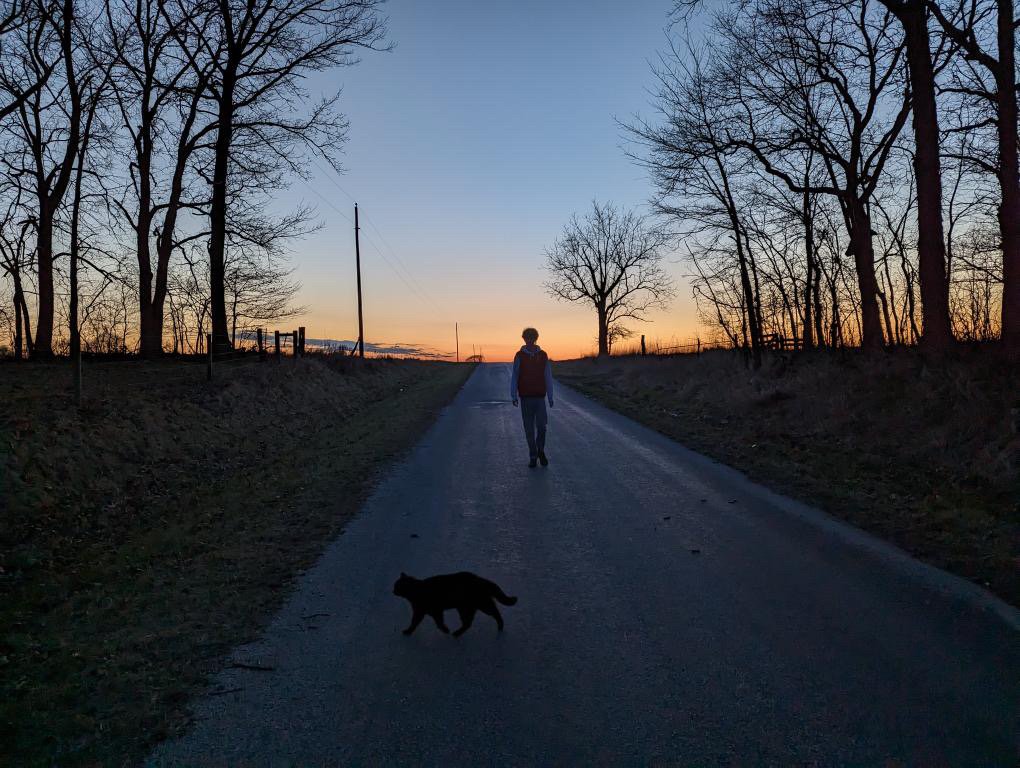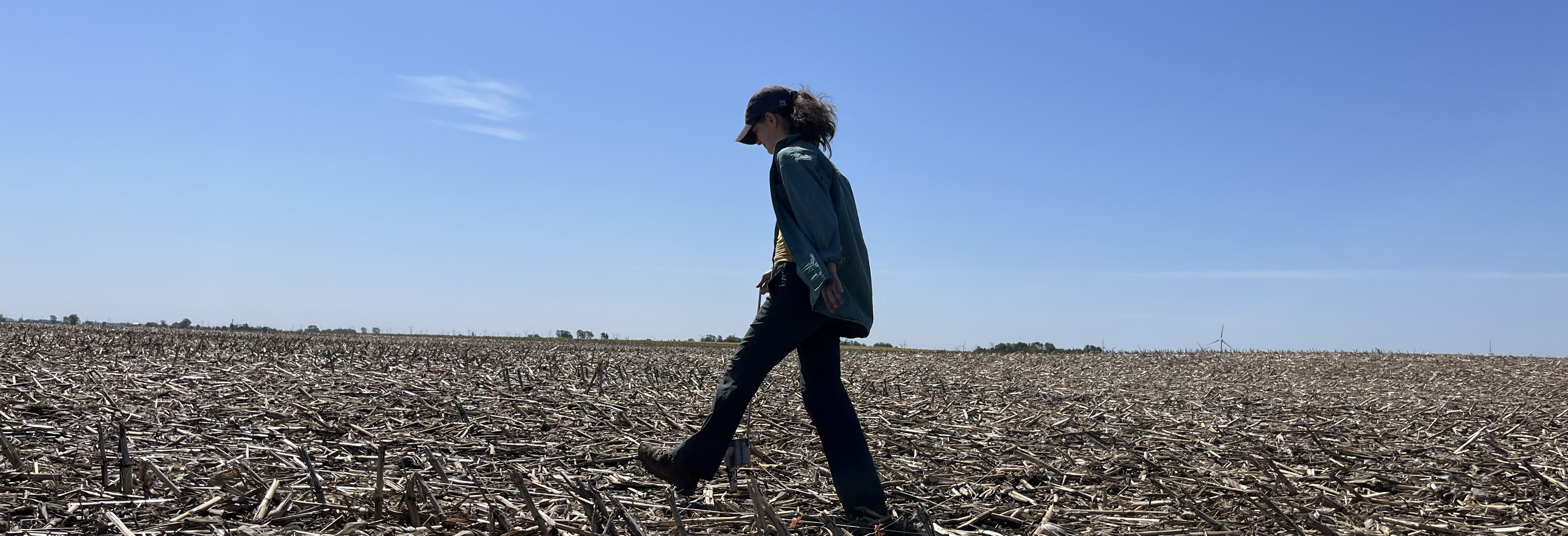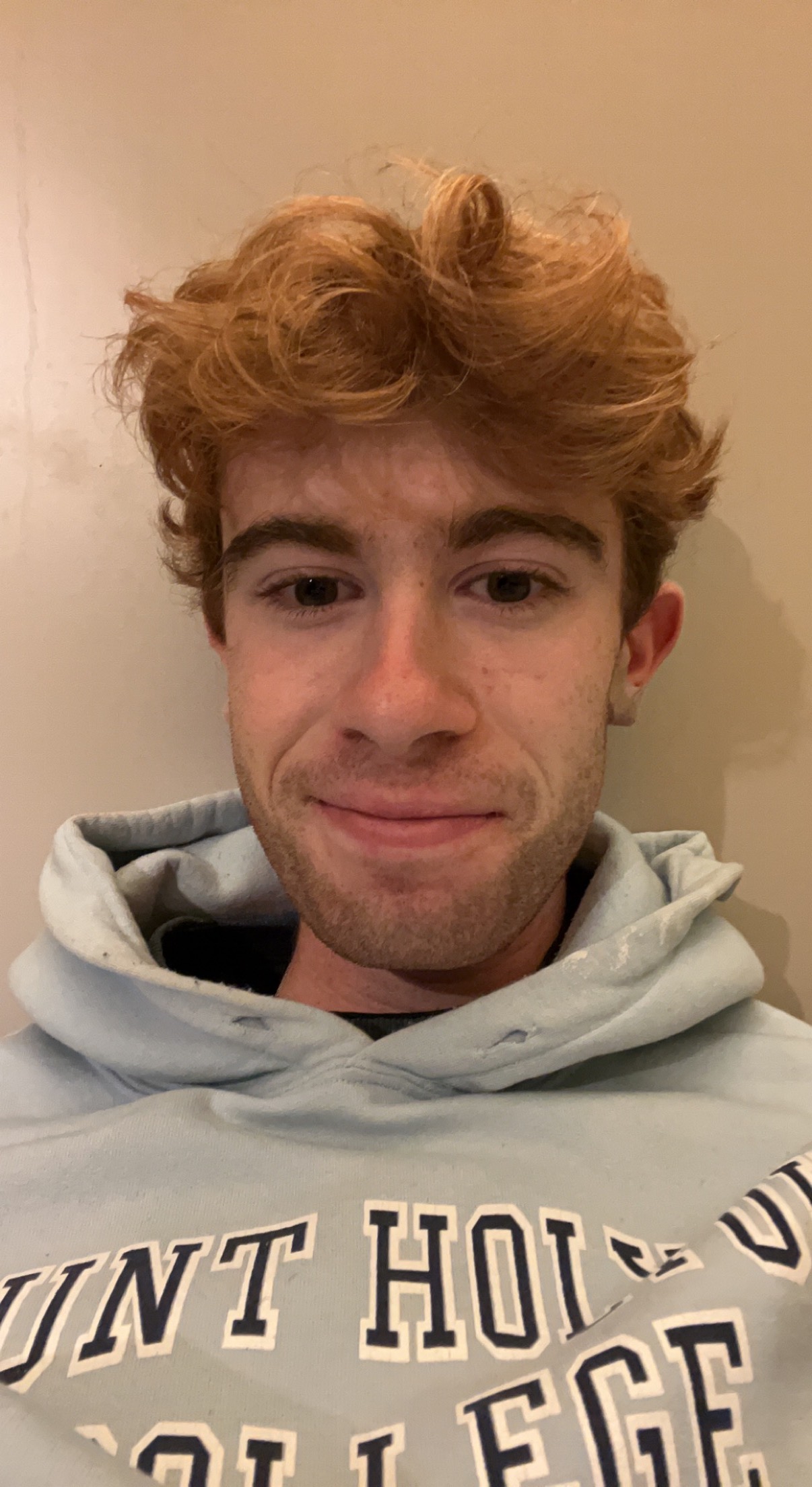If I am asked to describe what comes to mind when picturing Zumwalt Acres, I often resort, at least initially, to young adult novels which involve hidden worlds. The farm, in many ways, borders on the fantastical.
Zumwalt Acres (ZA) calls Sheldon, Illinois, home. The village, located in Iroquois County in eastern Illinois, has had a population hovering around 1,000 for over a century. Sheldon is located on the homelands of Kickapoo, Peoria, Kaskaskia, Potawatomi, Myaamia, and Ocethi Sakowin people. It is an hour and a half drive from Chicago. Sheldon’s demographics have also been constant: as of the 2020 census, they reported a 98% white population, and in the last presidential election, 77.5% of Iroquois County voted Republican. Sheldon epitomizes rural, red, farming, flag-waving Illinois.
Zumwalt Acres (ZA) was founded by the youngest generation of the Zumwalt family on land which has been in the family for over 150 years. The founders of this latest iteration of the farm, siblings Remi and Gavi Welbel, started ZA in 2020, the onset of the pandemic.
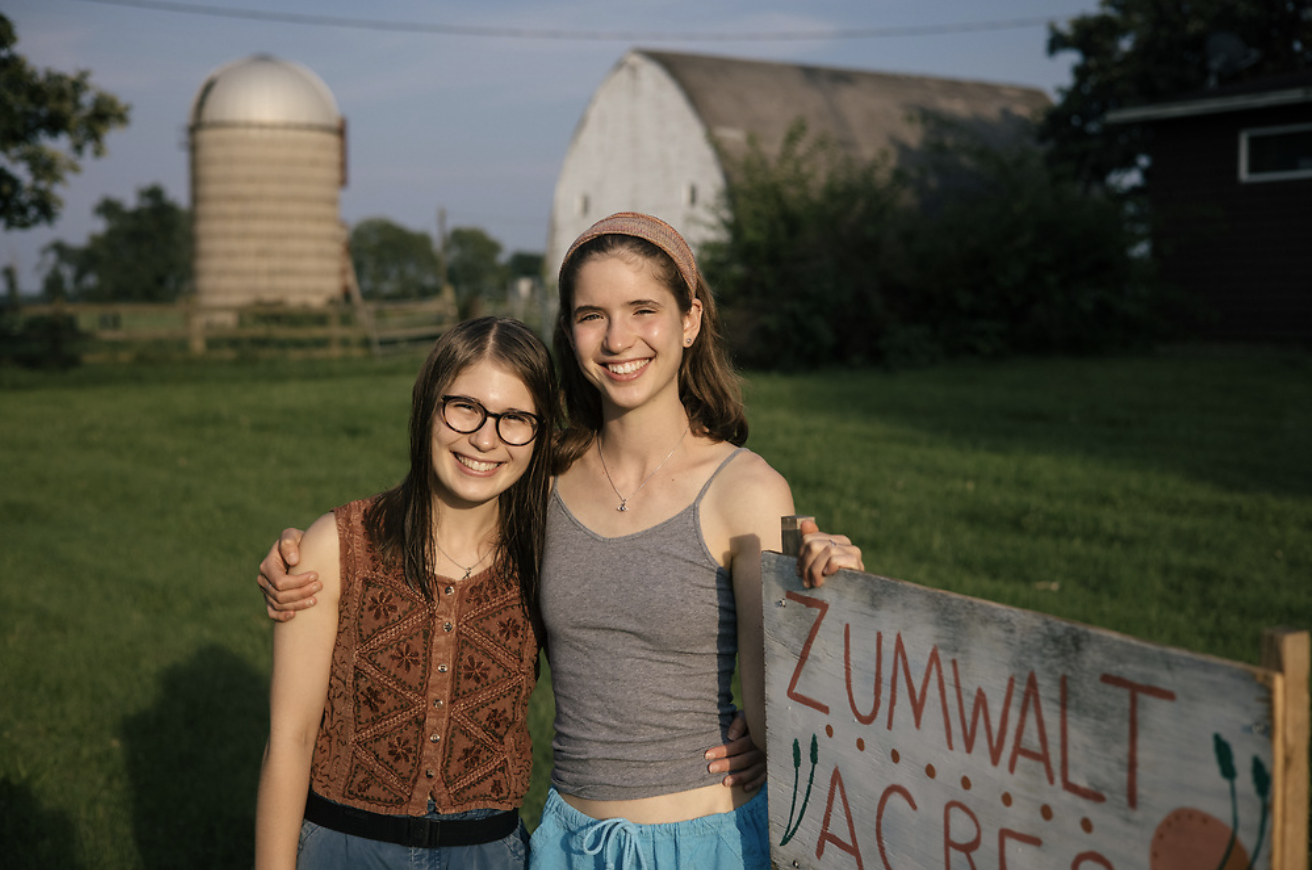
Remi Welbel (left) and Gavi Welbel (right).
This land has been in their family for six generations. The decision to transform the conventional farm into a perennial farm was seeded in the 1980s by Remi and Gavi’s father, JR, who grew up on the land and witnessed the devastating impacts of industrial agriculture on the soil, water, plant, animal and human communities. Motivated by this intergenerational dream and a strong relationship to Judaism and spiritual connection to land, in the summer of 2020, Gavi and Remi, along with a group of dedicated young adults, co-created Zumwalt Acres, a farm, community hub, and research center dedicated to ecologically sustainable and socially just land stewardship in Illinois. ZA integrates Jewish values, regenerative agriculture practices, and climate science to guide it in building a healthy and sustainable food system.
A move elsewhere
In February of 2023 I felt unwell. I was in the middle of my second trimester of college at the University of Chicago and amidst the transfer process. I had come to realize that the school was simply just not the right fit: even though I had so much of my family in the city, I longed for a smaller campus and for professors who paid attention to what I was learning, and not only to their graduate students. Unmotivated and cold, I trudged in the snow from class to class, knowing these would likely be my last times marching through the main quad and burrowing in the corner of the library with a book. Frustrated that it took me this long to realize my unhappiness there, I was ready to leave these places behind.
While going to school in Chicago, I became involved in efforts to reduce food insecurity in the local area. According to the Greater Chicago Food Depository, in 2023 one in five households in the greater Chicago area faced food insecurity. I joined the Food Recovery Network at my school and collected leftover meals from cafés, parts of dining halls, and restaurants in and around campus. We devised routes using data from the City of Chicago website to target specific locales and through GIS—a mapping program—to find the most efficient possible pathways. By the end of my time there, I was on the board and communicated consistently with those at public refrigerators and churches (our two main drop-off sites), collecting numbers on which foods we recovered were most successful, and which needed to be replenished.
These experiences drew me towards ZA, a farm which I had briefly heard about through fellow counselors at Camp Kinderland, a social justice-oriented sleepaway camp in western Massachusetts, who had been apprentices there in the years prior. The choice to apply to ZA was in some ways a logistical decision: I did not want to go back to my apartment in Brooklyn, fearing that I would feel aimless and out of sorts there, and I had an immense number of belongings accumulated over time which needed to be transported somehow. ZA’s location—a mere hour and a half south of Chicago—represented the ideal situation.
At first glance, ZA represented a break from my life at school, an intense change in location, and a new beginning.
More deeply, ZA symbolized to me an opportunity to absorb information on the food process: where produce starts, why some foods in the US are valued over others, and how we can make changes to a broken system (which was apparent to me in the immense food insecurity in Chicago). I was excited to be a part of a process where I could visualize progress, and I think since I struggled with seeing my personal growth at UChicago, engaging with the land hands-on felt as if it had the potential to be mentally rewarding.
On the morning of March 15th, my parents loaded cardboard boxes full of all of my belongings into the trunk of a rental car and we drove south. Gradually, the modern Chicago architecture gave way to mammoth windmills, which evoked the sensation of the dominating tripods on the cover of John Christopher’s book, a major part of both my mother’s and my childhood (and one of my only images of what rural life might look like). I called Remi to notify her that I was fifteen minutes away; she told me that she was in the greenhouse making soil blocks and probably unable to meet me right at the time I was arriving. Both my parents and I were confused as to why she would not walk outside to meet me. I soon learned that this “go-with-the-flow-ness” that Remi so clearly embodies is part of the ZA ethos, and while this moment initially stumped me, I soon realized that she acted in such a fashion to informally invite me onto a small farm family that operates without the usual pleasantries.
The White Mountains
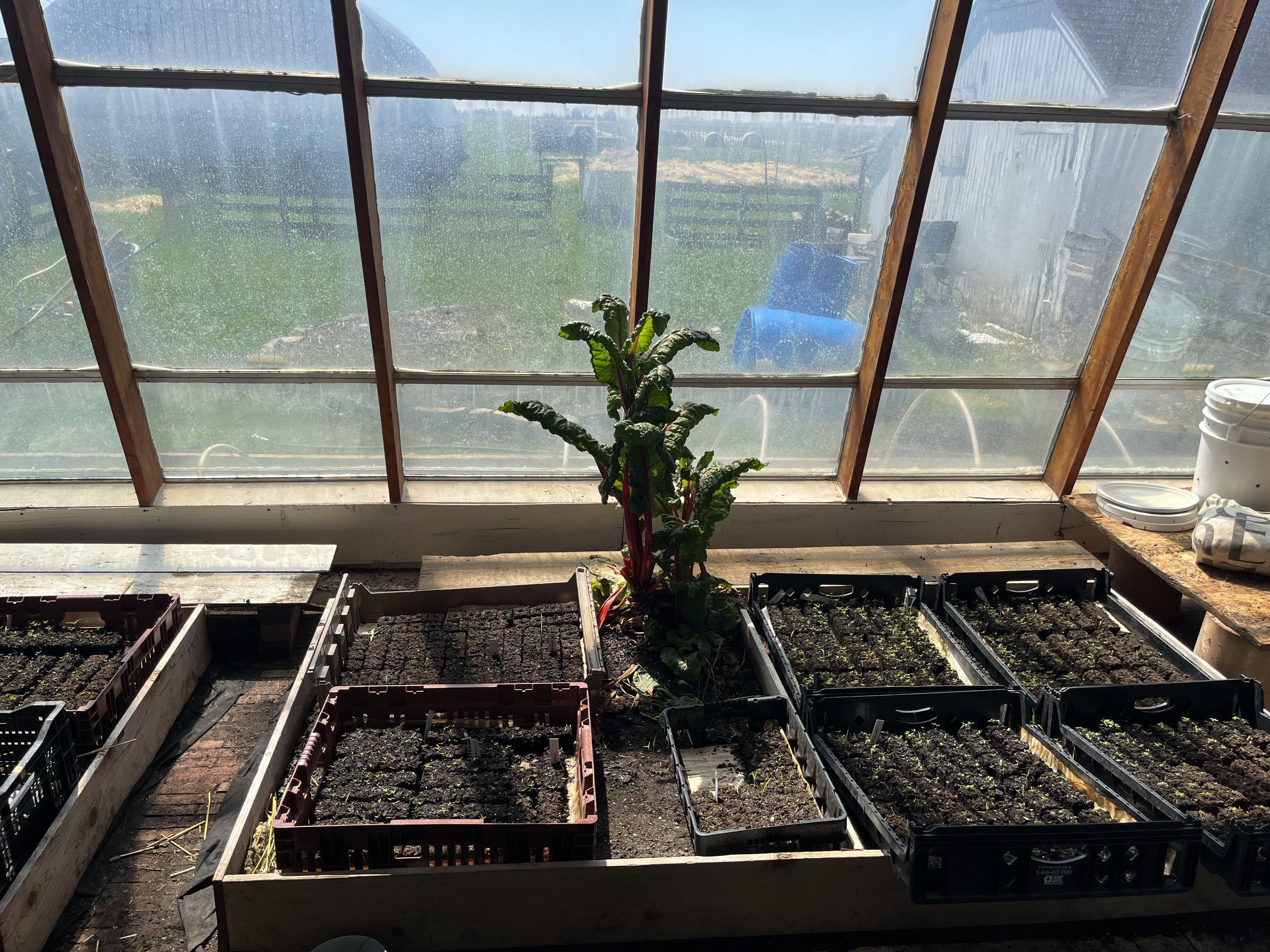
The soil blocks.
In my first week, I tried to settle in. I met the other apprentices who were there for the season: Claire Ivey, who had been a member of the first ever ZA cohort, and Acacia Berg, a new apprentice like myself, but unlike me, with a vast amount of farm experience and wisdom, having worked in Vinalhaven, Maine the previous year and having studied farmwork at Knox College. Lexi Weintraub, a member of the ZA network who lives in the neighboring town of Watseka, was also a core part of the team. Over the first couple days I was a mainstay in the greenhouse: I was taught how to soil block and the hose settings we used to water the plants. The greenhouse was one of our centers of attention during the cold months, for it was one of the only locations where plants could continue to grow amidst unfavorable outdoor conditions. Soon Remi gave me an official tour of the grounds. I didn’t know at the time that the strawberry patch and the goat garden would become the places on the farm I habituated most.
Later on that first week we traveled to the University of Illinois at Urbana-Champaign to break down one of the university’s massive greenhouses which they were donating to us (technically called a “high tunnel” but it was always the greenhouse to me) and transport it back to ZA. Taking the thing apart took a day: we used drills to unscrew the hundreds of screws that held it together and lugged the giant metal poles onto the bed of a big truck. It was cold and the wind blew violently, and we spent the entire day collapsing the greenhouse. It was painful just thinking about setting back up the huge metal frames and hundreds of assorted screws.
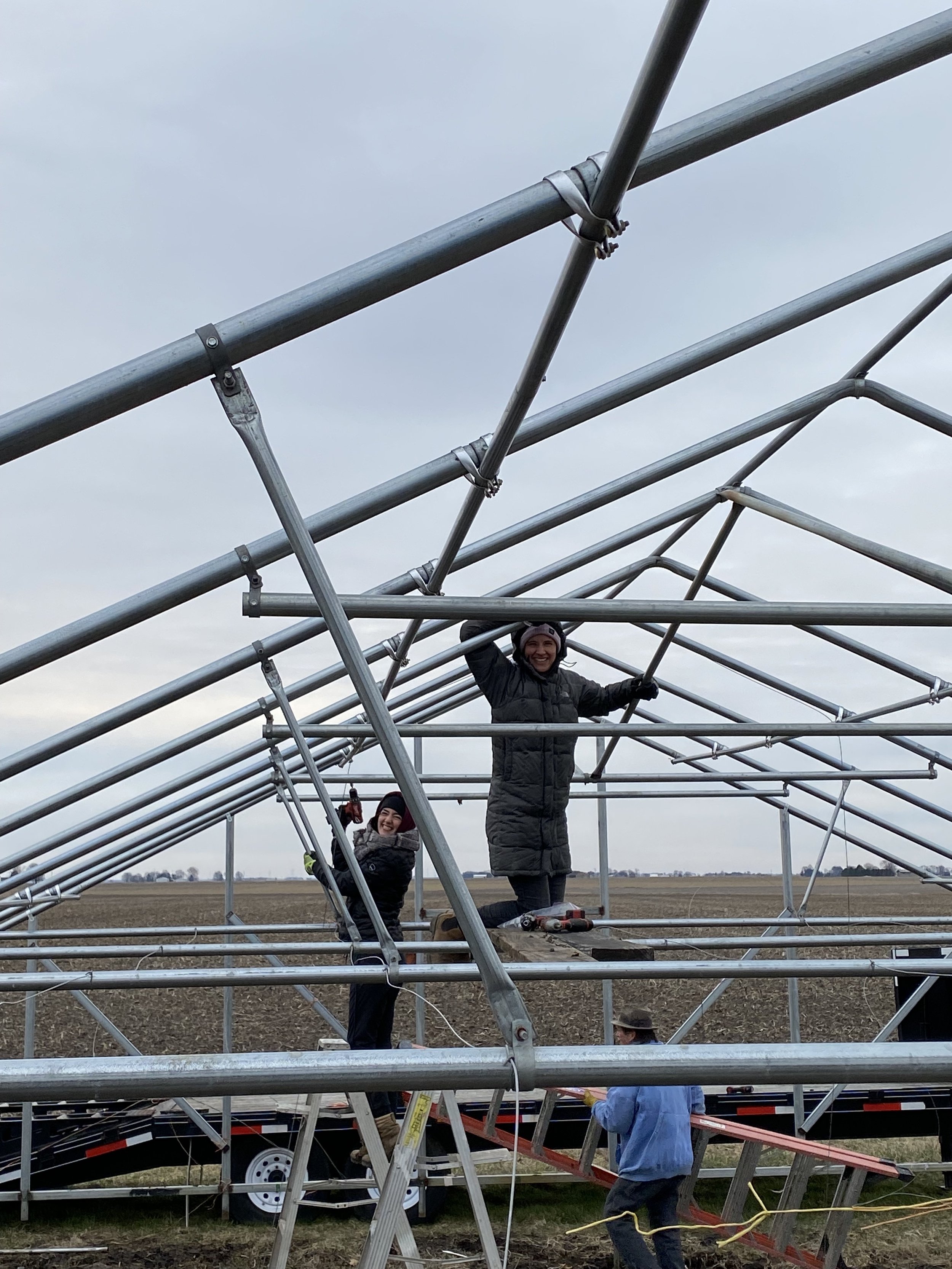
Taking down the high tunnel.
When I spoke to friends or family on the phone, I often felt the need to provide them with a rich taste of what I was up to, and moreover, I wanted to share what made ZA different from other farms. First, was ZA’s dedication to sustainability, and further, to regeneration. In general, regenerative farming is a combination of practices: minimizing tillage from tractors and heavy machinery, planting cover crops (crops whose job it is to maintain the health of the soil rather than to be harvested) and rotating through a variety of plants so that the farm can achieve biodiversity. In most “industrial’ farm operations today, there is very low biodiversity among plants (think of fields of wheat or corn), and thus, a prioritization of crop yield at the expense of soil health. Regenerative farms, in contrast, use zero pesticides or chemical fertilizers, and rather than huge machines costing hundreds of thousands of dollars apiece, rely on an immense amount of human power. I felt sore constantly after using the hoe to make beds ready for planting, as well as shoveling, and hand-weeding (AKA squatting for long periods of time). Regenerative agriculture breeds healthy soil, and tired but healthy bodies.
Judaism on the farm
Even more distinctive is ZA’s alignment with Jewish values. Such alignment does not confine the work that ZA does to only these Jewish values, but rather, such Jewish values the work ZA seeks to achieve. This language is present in ZA’s mission statement, found on their website, which reads:
Our work is grounded in environmental farming practices, scientific research, and community building, guided by Jewish values.
Some of these values arrived in my Jewish frame by way of my secular Jewish afterschool program, the Kinderland Kindershule, which is connected to the summer camp. Through Jewish history, old Yiddish stories and tales, and what were characterized to us as “Jewish ethics,” we became familiar with concepts like loving-kindness, compassion, and community-oriented learning and living. These sentiments do not generalize to all Jews, practicing or non-practicing, religious or secular, but are merely a description of what Jewish values look like to me.
Since the cohort was representative of a diversity of backgrounds, there were a number of spiritual upbringings at play. These differences were not apparent in day-to-day farm work, but they surfaced in communal meals, especially during dinners. At my first dinner I found myself telling the others what Kindershule was, and about some of the Yiddish writers I read, like I.L. Peretz and Sholem Aleichem. I could already sense a disconnect between my upbringing and those of the farmers who sat next me, my education done through Yiddish, the older language of Central and Eastern European Jews spoken extensively before the Holocaust, and Hebrew, the language synonymous with Judaism in the present day, and significantly, the language associated with all religious Jewish texts. I shared with the group one of my favorite stories: “If Not Higher” by Peretz. This fable taught me, from a young age, the significance of generosity wherever possible. We subsequently went around the table, recounting moments when Jewish teachings illuminated the importance of giving, and I felt welcome in a space which felt destined for more spiritual discussions.
Yet it was ZA’s observation of traditions which felt like it connected me most to my Jewish faith. Our Shabbat dinners, every Friday, are one such example. My family has never celebrated Shabbat, so it was new for me to try to limit my time on electronic devices as religious Jews do on Shabbat. Acacia often read the prayers during dinner as we closed our eyes and felt the warmth of the candles on our faces. Because I do not speak Hebrew, the words she spoke did not have any intrinsic meaning to me, yet after a few Shabbat dinners at ZA, I became accustomed to the prayers, and they represented the passing of time for me. Shabbat was important to me as a moment of reflection for the work which we had accomplished over that week. Others took the time to ruminate about what they were grateful for, or for sharing updates on their personal life. Shabbat took on a special character for me because of my individual Jewish upbringing and my inexperience with Hebrew, and ZA fostered a space where different interpretations and expressions of Shabbat could coexist.
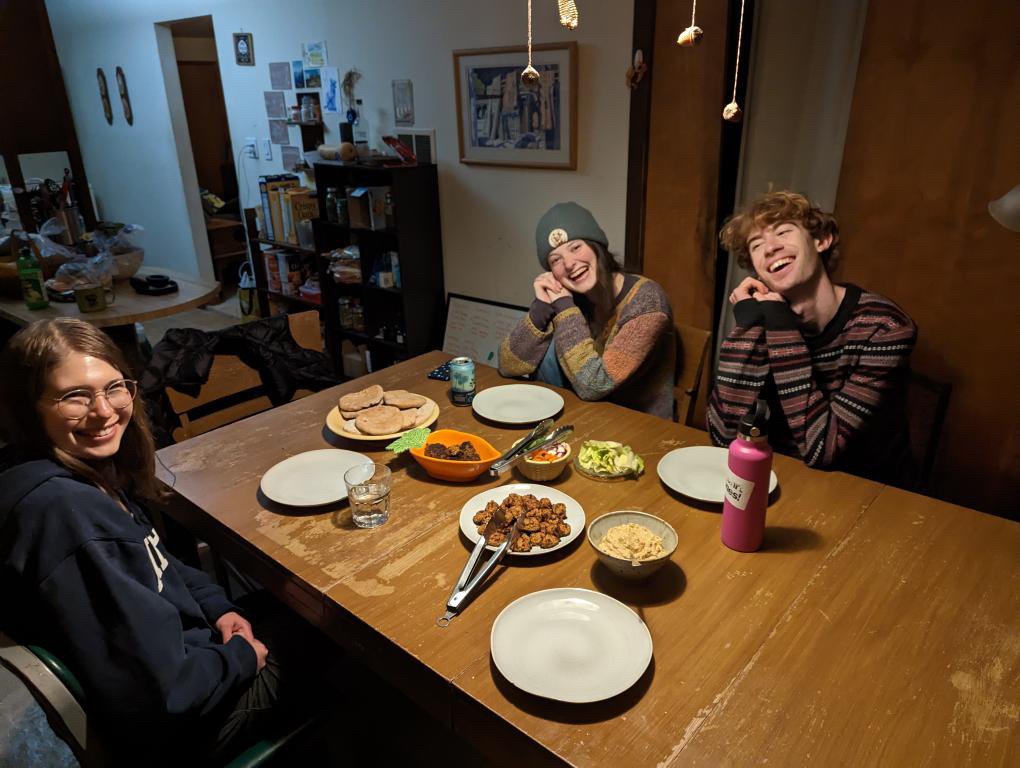
A Shabbat meal.
In short, the experience as a Jew at ZA was a journey into a different encounter with my culture. In the past, I celebrated Passover with my extended family in Chicago almost every year, reading from a Haggadah (Passover seder text) that was relatively unchanging from year to year. At ZA, the Haggadah included imagery of the farm and the prairie on each page, hand-selected Judaic texts from different cohort members, and various original and non-original poems, quotes, and photographs. This not only evolved yearly, but reflected the members present at the farm at that moment in time, and of their cultural upbringings, morals and values.
Passover at ZA was also unique because of its specific agricultural framing of the foods we eat. For example, the eggs and greens on the Passover seder plate celebrate spring, birth, and renewal. Our discussions integrated some of the classic themes of Passover with the work that we sought to accomplish at ZA. I remember conversing with Remi and Claire about the significance of perennials, which are plants that live for more than two years. These kinds of plants are vital in creating a regenerative, diverse ecosystem at the farm, where plants have a variety of lifespans and life cycles. Through the symbolic quality of these foods, we were able to connect classic Passover values with ideals which we wanted to see on the farm.
Some Jewish traditions had components which bridged spiritual and agricultural worlds explicitly. Between Passover and the Jewish holiday Shavuot is the Counting of the Omer, essentially counting the seven weeks between Passover and Shavuot. To keep track of each day we would write a note, poem, or some other practice of choice. Since Shavuot is known as “the holiday of harvest,” monitoring the days as they passed, one by one, allowed me to be more in touch with our crops, and I could tell which plants flowered quicker than others. Even for our indoor mushrooms, having a method of marking every day helped me to evaluate which types of spawn were most successful in our cultivation barrels.
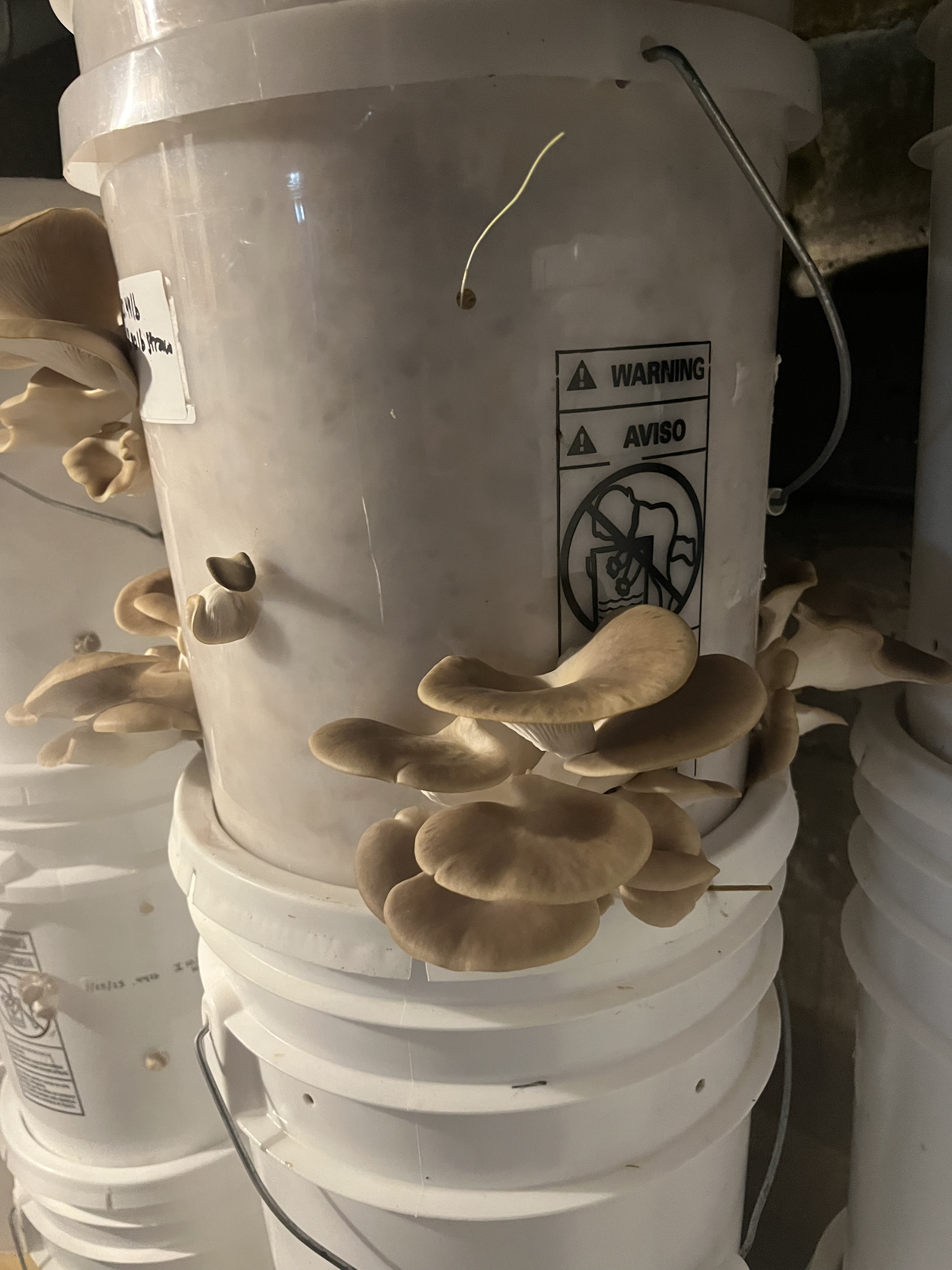
Growing gray oyster mushrooms.
In my view, the farm was a microcosm of Jews as an ethnic group in the US, trying to help other non-Jews in this country understand what being Jewish is about. My roommate, Claire, was a friend of Remi’s at Evanston Township High School, which is how she became acquainted with ZA. While she was introduced to Jewish traditions through ZA, we all largely learned together, collecting our shared knowledge in cultural spaces.
I admire ZA’s ethos when it comes to Jewish traditions: it is important not to force them on anyone else, but there is space for anyone to join and to learn. I found that ZA’s observation of these practices seriously engaged my secular Jewish faith, but more so instilled in each member of the cohort a profound sense of community, intentionality, and regeneration. Shabbat emphasized the latter most in terms of its onset and ending, both of which abide by the patterns of the sun rather than a time on the clock. During Shabbat, I felt embraced by the Earth and the tranquility which underscored such feelings gave me fuel for the impending farm work of the next week. We were intentional about the time during which we took a break so that we could be intentional during our time in the field.
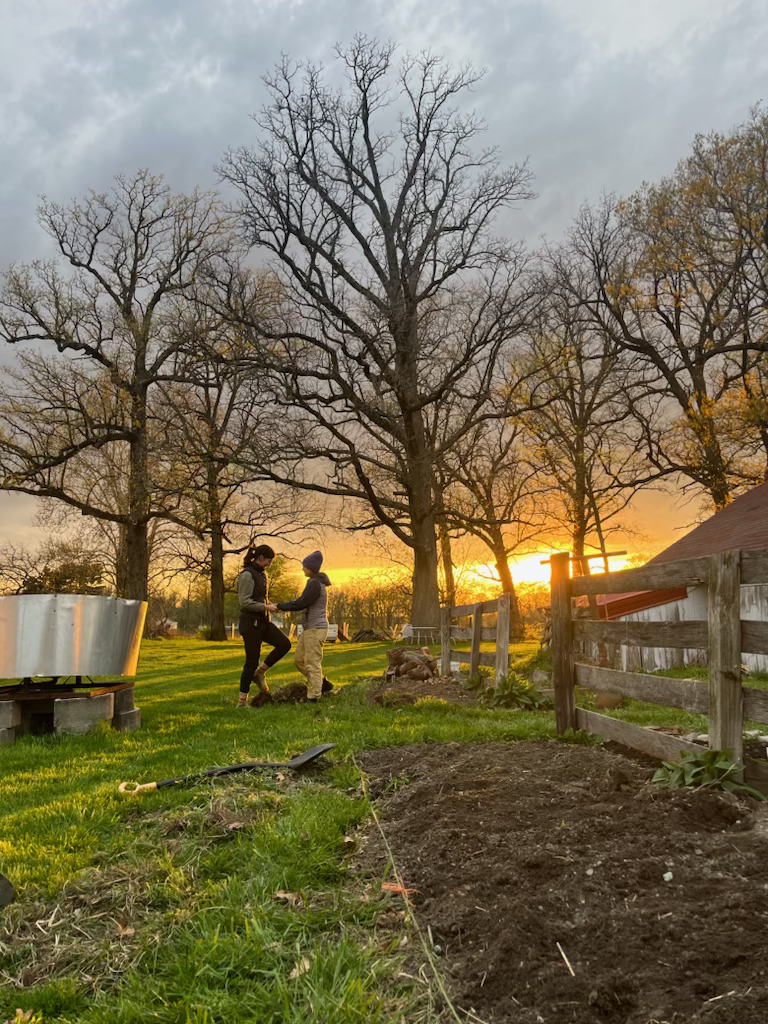
Sunset near the bayit beds.
There are other Jewish practices which warrant attention. ZA is a member of the Jewish Farmer Network, a collective of Jewish agricultural workers who are committed to building a more just and regenerative food system for all. We receive seed packets from the Network and, in return, provide them with some of our seeds, which are sent to other farms which are members of the Network. While very few seed packets that we receive have specific Jewish ancestry, we received several qishu’im seeds, a kind of Jewish ancestral squash. These seeds became a part of our “three sisters” bed, incorporating them into an indigenous practice wherein corn, bean, and squash are planted in mounds of soil. Each plant supports others: the cornstalk serves as a trellis for beans, the beans stabilize the corn in high winds, and the squash shades the ground, which keeps the soil moist and prevents the growth of unfavorable weeds in the area. When I think about the three sisters bed we cultivated, a line that JR wrote to his father in the 80s comes to mind:
We could create a system of agriculture that would lay the groundwork for generations; a system that would breathe life and health back into this ground.
JR’s expression evokes vibrant memories from my time at ZA. Assuredly, I did not always feel like I was “breathing life” into ZA’s soil. Slowly, however, the soil and I developed a reciprocal relationship, like the plants in the three sisters bed. I do not mean to insinuate that the farm “gave back to me” in terms of a harvest—which of course was the case—but more so that we developed a bond, which only bloomed as the spring continued its course. I grasped what the farm was like as I became more acquainted with it and as the soil was made more familiar with my presence. My choice of tools improved with experience in each bed, my hands found weeds with more ease, and I started to become one with the features of each spot, like the divot in one spot of the “bayit” (meaning house in Hebrew) bed, or the particular cross-sections of rock-wool on top of the strawberry plants, and the order of the rows of bok choy and radishes which grew on the outside of the tool shed. During these moments, I felt like there was something remarkable happening. Being Jewish felt different to me as I worked at ZA. It was a new experience because I was physically putting into practice some of the values I was absorbing. Treating the land with respect appeared to me as an extension of treating others with respect, and it was important that I brought this mindset to the farm work every day. A regenerative farm, Remi once told me, can only be accomplished with a sustainable way of thinking.
Closing thoughts
Being Jewish has no intrinsic correlation with developing a connection with the Earth. Yet the Jewish ideals which ZA embodies, through traditions and holidays, songs and meals, infuses into the discourse regarding regenerative agriculture, sustainability, and the next generation of farmers. Jewish values inform our work, as ZA’s website notes, but as a result of experiencing life on the farm, it is deeper than a one-sided dynamic. ZA’s ideology is imbued with Jewish principles from the beginning, and the farm makes clear that their teachings are meant to be viewed through the same lens: creating a better future for agriculture. How do I know that their rhetoric has made an impact on me? Because I carry with me the lessons I have learned from the farm, those that Remi and Acacia shared with me at the Passover table, that Lexi taught me in the mushroom tents, and that Claire gave me while soil sampling. I take them with me into my hometown of New York City and to my college town of Grinnell, Iowa. These lessons, therefore, are not place-dependent. I know that their ethics have seeped their way into my bloodstream because regeneration to me exists as a global term, not confined to the farm, and it sprouts up in conversations all around me. And it exists this way because others have made it their mission to teach it.
